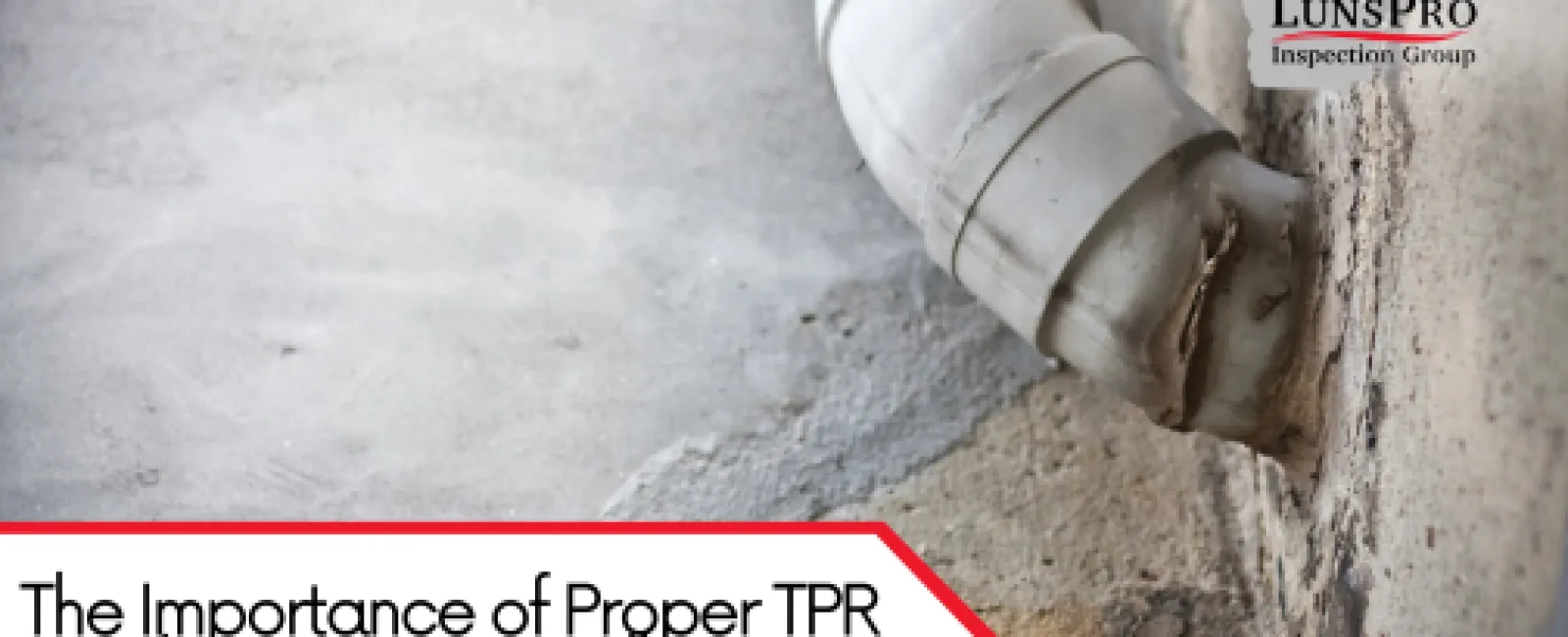In every home, safety begins with the systems that regulate utilities such as water, gas, and electricity. Among these, the water heater is one of the most important appliances for everyday living, yet also one of the most overlooked. Hidden in utility closets, garages, or crawl spaces, water heaters quietly deliver hot water throughout the home. However, without proper safeguards, they can pose serious risks. One critical safety feature is the Temperature and Pressure Relief (TPR) valve.
During a recent LunsPro Inspection Group evaluation, a certified inspector noted that a TPR discharge pipe was improperly terminating in a crawl space. While this might not seem alarming to a homeowner at first glance, the problem can create significant hazards. By design, the TPR valve protects against water heater explosions by releasing excess pressure and temperature. But for it to function safely, the discharge pipe must direct that flow to the exterior of the home in a visible location.
This article explains the role of the TPR valve, why proper discharge pipe installation is vital, and how home inspections safeguard residents from hidden risks. Through detailed residential and commercial inspections, LunsPro helps property owners ensure that systems as critical as water heaters are safe, compliant, and reliable.
What is a TPR Valve and Why Does it Matter?
The TPR valve is a safety mechanism installed on water heaters. Its purpose is to relieve excess pressure and temperature inside the tank, preventing catastrophic failure. When water inside the tank overheats, it expands and builds pressure. Without an outlet, that pressure could cause the tank to rupture or explode—a rare but extremely dangerous occurrence.
The discharge pipe attached to the TPR valve directs the hot water and steam away from the water heater to a safe, visible location. Ideally, this means outside the home or down to a floor drain where it can be easily noticed and does not create damage.
When a TPR discharge pipe ends in a crawl space, it creates several risks:
Hidden leaks - If the valve releases water, homeowners may not notice until structural damage or mold has developed.
Moisture damage - Crawl spaces are already prone to dampness; extra moisture can worsen mold growth, wood rot, and pest infestations.
Safety hazards - Superheated water released into an enclosed space poses scalding dangers during maintenance or inspection.
Common Problems with TPR Discharge Pipes
Improper discharge pipe installation is more common than many homeowners realize. Issues inspectors frequently encounter include:
Termination in a hidden space - As in the case noted, pipes should never end in crawl spaces, attics, or garages without drainage.
Excessive length or bends - Pipes with too many turns may restrict flow.
Improper material - Only certain approved materials, such as copper or CPVC, should be used.
Blocked or capped outlets - A capped discharge pipe eliminates the safety function altogether.
Pipes discharging upward - This traps water and prevents the valve from working correctly.
Each of these problems reduces the valve's effectiveness and puts both the home and its occupants at risk.
How Home Inspections Identify TPR Issues
Most homeowners rarely look at their water heater beyond adjusting temperature settings. This is why professional home inspections are so critical. A trained inspector from LunsPro Inspection Group will carefully evaluate the water heater, ensuring that the TPR valve is present, the discharge pipe is properly installed, and the setup meets safety standards.
During residential and commercial inspections, inspectors often find that TPR discharge pipes are either missing or incorrectly routed. By identifying these issues, they can recommend correction by a licensed plumber before the home is sold or occupied. For buyers, this knowledge protects against inheriting a safety hazard. For sellers, correcting the issue demonstrates that the property has been responsibly maintained.
Broader Risks of Improperly Installed Water Heater Components
The TPR valve is only one aspect of water heater safety. Improper installation of other components—such as venting, electrical connections, or expansion tanks—can also pose hazards. However, because the TPR valve protects against explosions, it is one of the most critical items inspectors review.
In homes across Georgia, especially older properties in areas like Atlanta, Alpharetta, and Athens, outdated water heaters may lack proper safety measures altogether. This makes LunsPro's home inspections even more valuable. By carefully reviewing water heater components, inspectors provide homeowners with insights that go beyond simple functionality, focusing on long-term safety and performance.
Correcting a TPR Discharge Pipe Issue
When a TPR discharge pipe is found to be improperly installed, homeowners should contact a licensed plumber immediately. Correcting the issue typically involves:
Routing the pipe to the exterior of the home or to a visible floor drain.
Ensuring the pipe terminates no more than six inches above the ground.
Using approved piping material.
Making sure the pipe is unobstructed and angled downward.
The repair is generally straightforward, but the peace of mind it brings is invaluable. A properly installed discharge pipe ensures that if the TPR valve activates, water is safely directed away from the living environment.
Why TPR Issues Highlight the Value of Inspections
The discovery of an improperly terminated discharge pipe demonstrates the importance of thorough home inspections. Many of these issues go unnoticed by homeowners until it is too late. By choosing LunsPro Inspection Group, property owners gain access to certified inspectors who are trained to identify small but crucial details.
Through our comprehensive residential and commercial inspections, LunsPro not only highlights visible concerns but also educates clients about why those concerns matter. This focus on safety, reliability, and transparency ensures that both buyers and sellers feel confident moving forward with their real estate transactions.
A TPR discharge pipe may seem like a small component in a home's overall plumbing system, but its role in protecting against water heater explosions is vital. When the pipe terminates in the wrong location—such as a crawl space—it creates hidden risks that compromise both safety and structural integrity.
Thanks to LunsPro Inspection Group, homeowners across Georgia have access to expert home inspections that reveal these problems before they cause harm. Whether through residential or commercial inspections, LunsPro's certified inspectors remain committed to safeguarding properties, protecting investments, and ensuring peace of mind.
For buyers, sellers, and property owners, proper water heater safety starts with knowledge—and knowledge begins with a professional inspection.

